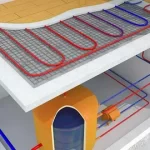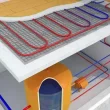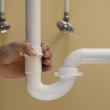Thermal insulation acts as a barrier, keeping your home warm in winter and cool in summer. It does this by preventing the transfer of thermal energy across an area. In conditions where two materials are at different temperatures, an insulating barrier can be used to prevent these areas from becoming the same temperature. Take for example the roof of your home, an uninstalled roof can account for up to 35% of summer heat gains and winter heat losses. Installing roof insulation can reduce fluctuating indoor temperatures and in turn the reliance on heating and cooling appliances.
Areas of the Home to Insulate

Wall insulation:
Exterior walls act as a barrier between the comfortable indoors of your home and the elements outside. During winter, around 15% to 25% of heat is lost through uninsulated walls, leading to higher dependence on heating appliances. The most common thermal insulation materials used for your walls are glasswool and polyester products. Product such as Knauf Earthwool and Bradford Gold batts are popular as they are low-itch, durable and non-combustible.
Ceiling insulation:
This insulation is designed specifically for ceiling spaces and can be installed from below the ceiling during construction or in an existing home that has access to this area. It is available in a range of thicknesses and R-values suitable for your geographical location within Australia.
Roof insulation:
A range of products is available for residential and commercial roof applications. It is possible to install your own roof insulation as a DIY project. Before deciding to install your own roof insulation, check out the following; is there easy to get into the roof space, no dampness or condensation problems, and stud joists are evenly spaced. If these boxes are ticked installing your roof insulation can be a great DIY project. Just remember safety first!
Mid Floor insulation:
An area that is often forgotten in your home to install thermal insulation between the floors of your home. There are many benefits to gain from this, however, one of the most important is that you can create climate zones within your home. This means that you may only want to heat or cool one storey of your home and with mid-floor insulation, this prevents heat loss into the storey above or below. Keeping that are of your home at a stable desired temperature.
Underfloor insulation:
An uninsulated underfloor may be losing as much as 20% of its heating and cooling energy. Underfloor insulation can make your home more comfortable and your floors warmer to touch. A common thermal insulation material used for the underfloor area is a polyester roll called Greenstuff Polyester underfloor roll. it is non-allergenic, safe and non-toxic to handle making it a great product to use for DIY retrofit jobs.
How much can I save with thermal insulation?

It’s not always easy to estimate in exact energy savings upfront in dollar terms but a fully insulated home could save you up to 45% per year. Furthermore, it is estimated that insulation can pay itself off in around five to six years. So, what are you waiting for? Begin installing insulation in the main areas of your home, such as roof insulation and underfloor insulation, to experience the benefits today!

















